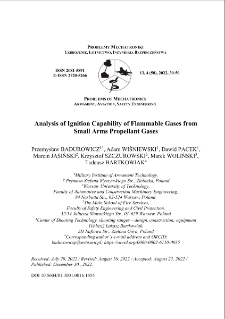Nasza Biblioteka Cyfrowa udostępnia 1 868 obiektów cyfrowych
Obiekt
Tytuł: Analysis of Ignition Capability of Flammable Gases from Small Arms Propellant Gases ; Analysis of Ignition Capability of Flammable Gases from Small Arms Propellant Gases
Tytuł odmienny:
Analiza możliwości zapłonu gazów łatwopalnych od gazów prochowych broni strzeleckiej ; Analiza możliwości zapłonu gazów łatwopalnych od gazów prochowych broni strzeleckiej
Współtwórca:
Adam WIŚNIEWSKI, Dawid PACEK1, Marcin JASIŃSKI, Krzysztof SZCZUROWSKI, Marek WOLIŃSKI, Tadeusz BARTKOWIAK ; Adam WIŚNIEWSKI, Dawid PACEK1, Marcin JASIŃSKI, Krzysztof SZCZUROWSKI, Marek WOLIŃSKI, Tadeusz BARTKOWIAK
Abstrakt:
The article presents the results of tests on the temperature of propellant gases shortly after the bullet leaves the barrel. The temperature and movement of these gases were recorded with thermal cameras and a high-speed camera. Weapons with and without muzzle devices (flash suppressor, silencer) were used. The aim of the research was to check the capability to ignite flammable gases located in the vicinity of the propellant gases produced during firing. Comparison of the maximum temperature of the propellant gases and the ignition temperature of the flammable gases makes it possible to determine the probability of fire. The lowest temperature of propellant gases was in the case of shooting with 9 × 19 mm bullets with the lowest kinetic energy (518 J), and the highest temperature of these gases was during shooting with 5.56 × 45 mm HC (SS109) bullets with the highest kinetic energy (1,785 J).
;
The article presents the results of tests on the temperature of propellant gases shortly after the bullet leaves the barrel. The temperature and movement of these gases were recorded with thermal cameras and a high-speed camera. Weapons with and without muzzle devices (flash suppressor, silencer) were used. The aim of the research was to check the capability to ignite flammable gases located in the vicinity of the propellant gases produced during firing. Comparison of the maximum temperature of the propellant gases and the ignition temperature of the flammable gases makes it possible to determine the probability of fire. The lowest temperature of propellant gases was in the case of shooting with 9 × 19 mm bullets with the lowest kinetic energy (518 J), and the highest temperature of these gases was during shooting with 5.56 × 45 mm HC (SS109) bullets with the highest kinetic energy (1,785 J).
Miejsce wydania:
Warszawa
;
Warszawa
Wydawca:
Wojskowa Akademia Techniczna ; Wojskowa Akademia Techniczna
Data utworzenia:
Data złożenia:
Data akceptacji:
Data wydania:
Rozmiar:
Identyfikator:
oai:ribes-88.man.poznan.pl:2654
Sygnatura:
DOI 10.5604/01.3001.0016.1455 ; DOI 10.5604/01.3001.0016.1455
ISSN elektroniczny:
ISSN drukowany:
Język:
Licencja:
kliknij tutaj, żeby przejść ; kliknij tutaj, żeby przejść
Właściciel praw:
Wojskowa Akademia Techniczna ; Wojskowa Akademia Techniczna
Strona początkowa:
Strona końcowa:
Tom:
Słowa kluczowe:
mechanics, small arms, transitional ballistics, propellant gases, thermal camera ; mechanics, small arms, transitional ballistics, propellant gases, thermal camera
Kolekcje, do których przypisany jest obiekt:
Data ostatniej modyfikacji:
13 paź 2025
Data dodania obiektu:
13 paź 2025
Liczba wyświetleń treści obiektu:
0
Wszystkie dostępne wersje tego obiektu:
https://ribes-88.man.poznan.pl/publication/2983
Wyświetl opis w formacie RDF:
Wyświetl opis w formacie OAI-PMH:
| Nazwa wydania | Data |
|---|---|
| Analysis of Ignition Capability of Flammable Gases from Small Arms Propellant Gases | 13 paź 2025 |
Obiekty Podobne
Przemysław BADUROWICZ Wiesław STĘPNIAK, Mirosław ZAHOR
Przemysław BADUROWICZ Przemysław KUPIDURA,Wiesław STĘPNIAK, Bartosz FIKUS
Przemysław BADUROWICZ Przemysław KUPIDURA, Bartosz FIKUS

